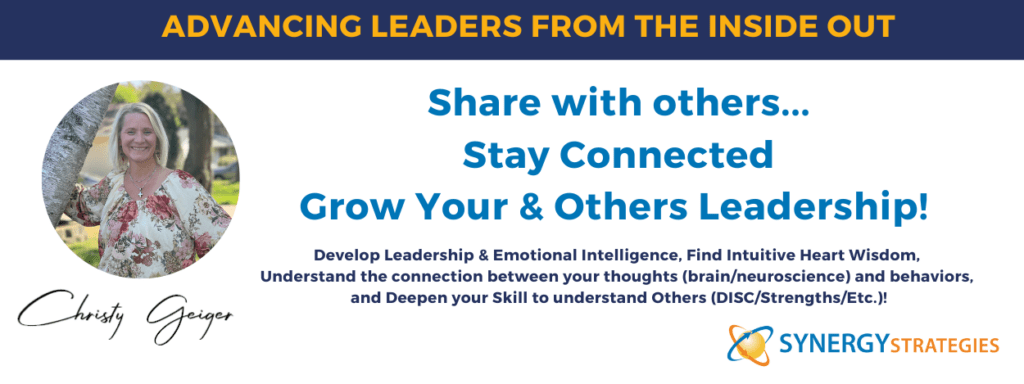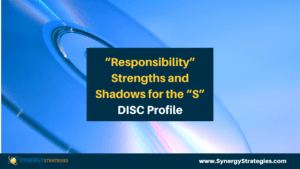Building on our recent posts about Emotional Intelligence (EI) and its crucial role in leadership, I want to dive deeper into how you can practically apply these insights to enhance your leadership effectiveness. Here are some actionable strategies and reflections to support our ongoing efforts to develop and strengthen our EI as leaders.
Essential Actions to Enhance Emotional Intelligence
- Understand the Role of Self–Awareness Emotional Intelligence Self-awareness is the cornerstone of emotional intelligence. At the foundation of being able to develop ANY EI skills, a person must be able to sharpen their skill of self-awareness. It is important to watch out for our ego’s natural defensiveness that would say, “Oh! I am self-aware” and realize the challenge of self-awareness is recognizing our blind spots, pet shortcomings, and justifiable low EI activity. It is DIFFICULT to truly be self-aware. If self-awareness doesn’t feel challenging, you’re likely not digging deep enough. EI Strength builder – Try Daily Reflection: Allocate time each day to reflect on your emotional responses and interactions. Journaling can be a powerful tool here. Ask yourself: What emotions did I experience today? How did they impact my decisions and interactions? What emotions were useful and what emotions caused me to be less of a great leader than I would like?
- Embrace Empathy Beyond Traditional Boundaries Empathy is another core skill of EI. In the past, leadership boundaries were often rigid, with little room for personal conversations or emotional connection. Leaders were encouraged to maintain distance, avoiding personal matters to keep professionalism intact. However, modern leadership shifts this perspective—empathy encourages leaders to move beyond these traditional boundaries by engaging with the whole person. Leaders are now more open to understanding their team members’ personal lives, struggles, and cultural backgrounds. While empathy requires crossing these once-strict lines, it’s essential to still maintain healthy emotional boundaries, ensuring leaders provide support without overstepping or losing focus on the bigger organizational goals. EI Strength builder – Empathy in Action: Practice active non-judgmental listening during one-on-one conversations. Instead of planning your response while others are speaking, focus entirely on understanding their perspective. Use phrases like, “I hear you saying…” to check that you have heard correctly and to honor their feelings and thoughts even if you do not understand or agree. Hearing isn’t about agreement—it’s about understanding another person’s reality and perspective.
- Navigate Conflict with Emotional Intelligence Conflict is inevitable in any leadership role, but how you handle it can make a huge difference. Often leaders have taken a pass on dealing with conflict by “empowering” whoever has the conflict to “work it out”. The purpose of leadership is to remove obstacles that our team is struggling to resolve. It does not mean rescuing them, but it does mean not being afraid of conflict, and understanding conflict represents a gap that needs support and attention. As leaders, it is important to see conflict as red flags and lean even more into our EI strengths to not get triggered or engaged in the emotion of the conflict but rather to rise about it ourselves and help others to rise above to see the themes, gaps, and issues to find the common ground, goal and solutions. EI Strength builder – Conflict Framework: When faced with conflict, use the SCARF model (Status, Certainty, Autonomy, Relatedness, Fairness) to assess and address emotional triggers. For instance, if someone feels their status is threatened, acknowledge their contributions, and find ways to affirm their value. Use this to “de-SCARF” someone so that from everyone’s “executive briefing center” of their brain, new solutions can be found.
- Balance Empathy with Results One of the critical challenges leaders face is balancing empathy with the drive for results. Finding this balance is not only possible but essential for effective leadership. Empathy is about understanding and seeing people as human. Results are about accountability, communication, and actions. High EI leaders do not sacrifice results in order to have empathy. They have empathy while holding the results and seek to find the both-and way to ensure compassion for the person and results of the job both happen. EI Strength builder – Results with Empathy: Set clear goals but also check in on your team’s well-being. For example, after setting a challenging target, follow up with a conversation that focuses on support and understanding their challenges. This approach helps maintain motivation and trust.
- Develop Emotional Agility Emotional agility is our ability to manage our emotions effectively AND adapt to changing circumstances. In today’s fast pace of business and change, we must be agile. This isn’t about erratic changes; it’s about staying calm, centered, and wise to navigate tough challenges to adapt and stay in flow toward the bigger picture. Rigidness, emotional meltdowns, and a lack of ability to adjust are low EI versus growing the skill of leading well, being clear and directed but recognizing when adjustment is needed, and doing it with grace, communication, and a level head. EI Strength builder – Practice Agility: Incorporate techniques like mindfulness or breathing exercises to stay grounded during stressful situations. When you feel overwhelmed, pause, and use a tool like the Heart Math Meditation to gain insight into your emotional state and adjust your approach accordingly.
- Empowering Teams through Emotional Intelligence Finally, as leaders we are developing EI so we handle ourselves better and also it is critical to EI to empower our teams. Leaders who demonstrate emotional intelligence can create a more engaged and resilient workforce in contrast those with low EI tend to demotivate, discourage, and devalue their team. They “accidentally” send messages to the team that causes them to feel unseen, frustrated, and in conflict about the investment they make in their work and the company. When leaders are using EI to empower their teams, not only have they used empathy to see the whole person or are engaged to support a team member through conflict, but they are being a critical center to create safety, trust, and well-being among the team. When this safety is present, people can take risks, fail forward, learn, and grow. They are more open and can grow their own EI rather than needing to protect and hide from low EI activity and impact. EI Strength Builder – Empowerment Strategies: Regularly solicit feedback from your team about how they’re feeling and how you can better support them. Use their input to make informed decisions that balance organizational goals with their needs.
By integrating these strategies, you can deepen your understanding and skills of emotional intelligence in your leadership. Remember, the journey to mastering EI is ongoing, and it involves consistent practice and reflection. The areas of our weakest EI take the most work and the longest to develop. Our egos are always tempted to go for what feels easy, while in the areas that feel hard, our egos will minimize their importance or value. Study the list above and which area irritates you the most or do you want to blow off the most? Consider if that might be your #1 opportunity. Pick one area you want to practice and let me know how it goes! Share your thoughts and experiences!






